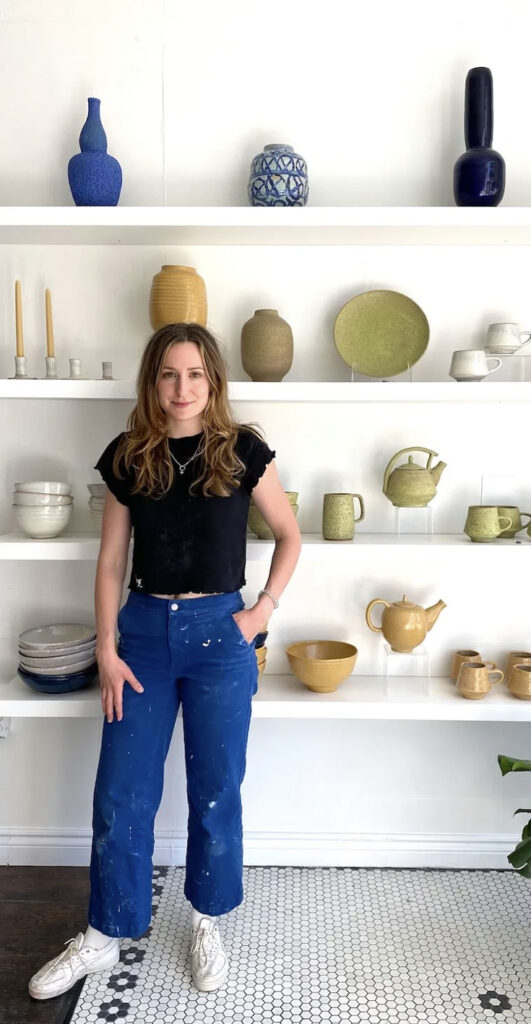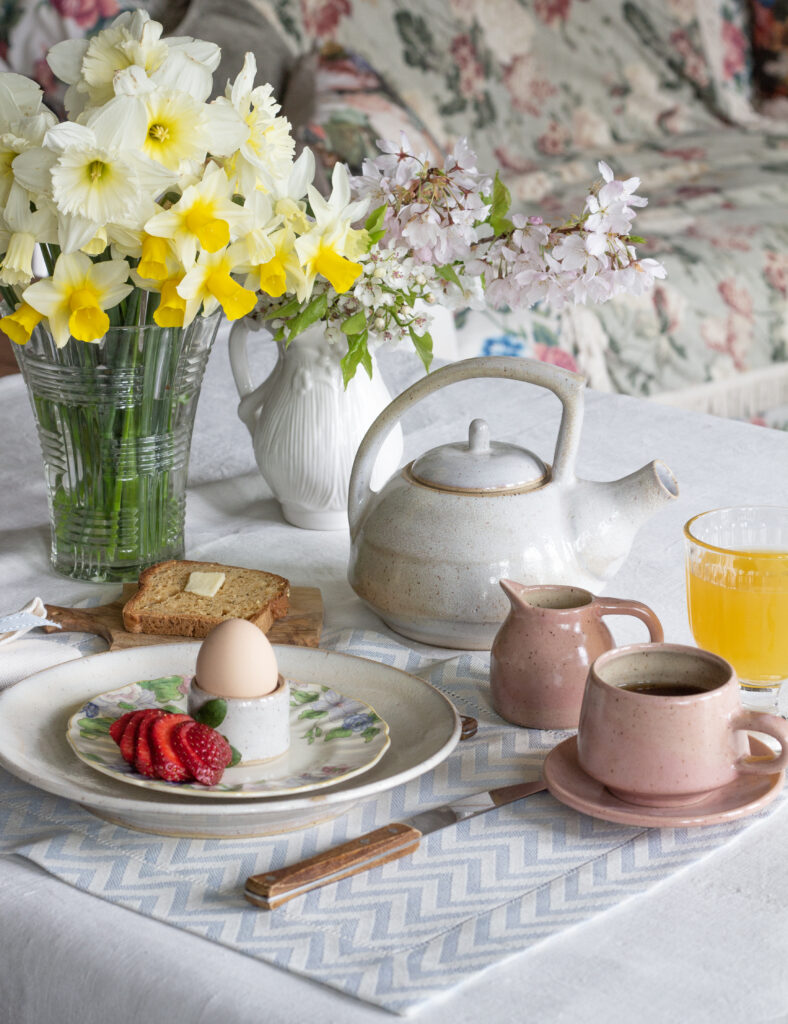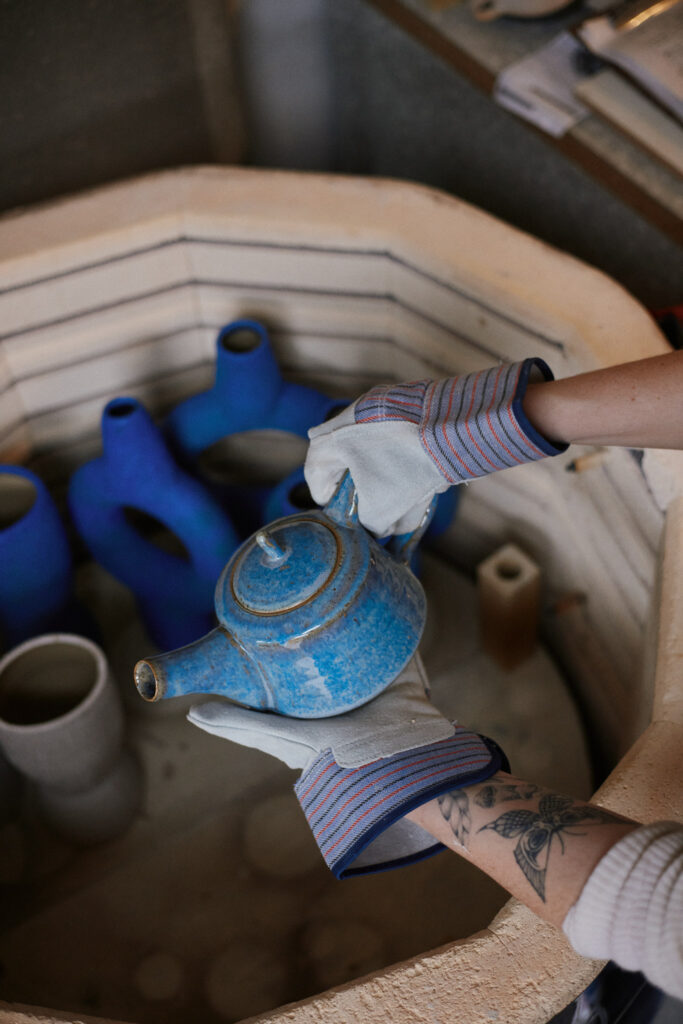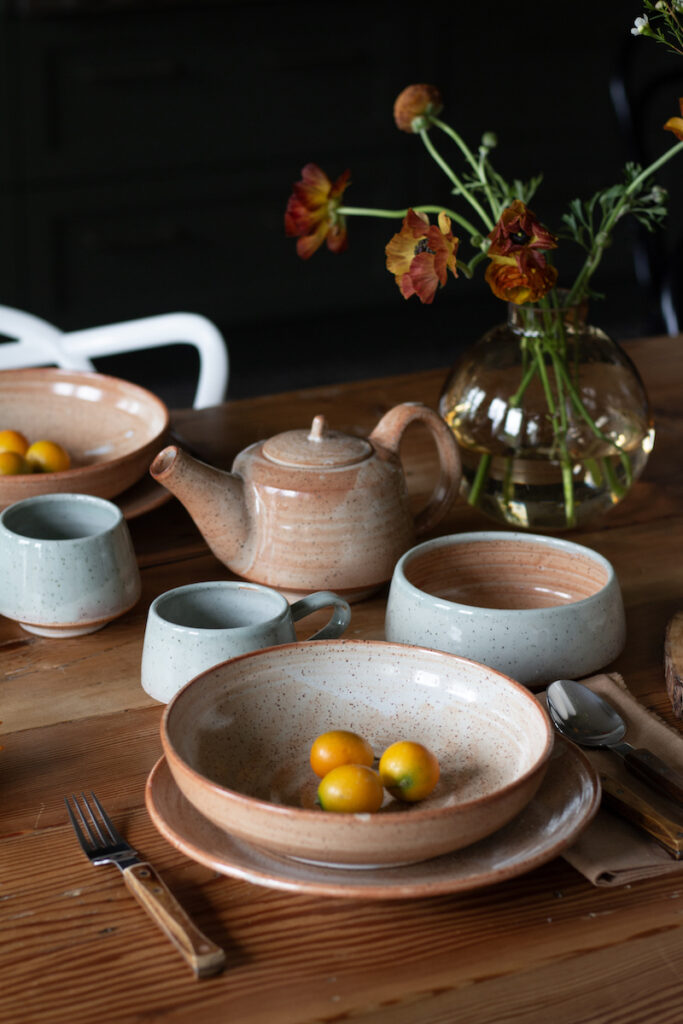Welcome to an exclusive interview with Kate Metten, the visionary artist behind a world of captivating ceramics. In this intimate conversation, we delve into the heart of Kate’s creative journey, exploring the fusion of tradition and contemporary flair that defines her renowned ceramic atelier.
With each handcrafted piece, Kate infuses passion, creativity, and a profound connection to her craft. Join us as we uncover the stories behind her elegant designs, her dedication to preserving movement in every form, and the inspiration drawn from her beloved East Vancouver.
Get ready to be inspired by Kate’s unique artistic vision and the timeless beauty she brings to the world of ceramics…

Can you tell us about your journey into ceramics? What drew you to this medium?
Transitioning out of dance in my teens, I was attracted to the physical and repetitive nature of wheel throwing. I also liked the intellectual challenges of glaze chemistry research and testing local clays.
I grew up playing with river clay in South Vancouver and from a young age took ceramics classes and then studied ceramics more formally at Concordia University Montreal, Penland School of Crafts North Carolina, and graduated with a BFA from Emily Carr University of Art and Design in 2017.
Following that, I had the privilege of receiving a BC Arts Council Early Career Development Grant to pursue a ceramic apprenticeship with the Ngan family on Hornby Island to focus on production throwing and natural mineral testing in clay bodies and for glazes.
I have since done international artist residencies in Denmark and Berlin. When I returned from Europe most recently, I opened an atelier on Main Street which operated as a Bernard Leach style workshop for two years. We are now transitioning into a private studio that allows for more experimentation and accommodates my painting practice also.
Your work is described as blending tradition with contemporary flair. How do you find the balance between honouring tradition and expressing modernity in your pieces?
Traditional forms are filtered through my hands for a contemporary perspective. Looking to history for inspiration feels more authentic to me than drawing directly from what’s being made now.
My understanding of ceramics comes from studying Canada’s BC potters who thrived during the 1960s back-to-the-land movement of West Coast ceramics. I adapt traditional processes like raw material sourcing into a contemporary context by collecting clay from urban land cuts like construction sites to re-contextualise historic processes, bringing the site’s historicity and politics of land use into the materiality of the piece.
East Vancouver seems to be a significant influence on your work. How does the local environment inspire your creative process?
I am a Vancouver-born artist. I worked at Stan Rath’s independent art supply shop in East Van for a decade and was offered a storefront in the same heritage triangle building at Main and Kingsway, a hustling block where stop n’ chats drive neighbourly connection.
My studio operated in that retail space on Main for 2 years and I have recently moved to an industrial studio space in Strathcona. Relationships drive my business. The product creates a personal connection between myself and my community.
Each mug is a love note. People who know me think of me when they use my work. Clients share and give to friends. There is a growing network of collectors of Kate Metten Ceramics expanding beyond East Vancouver to the global scene.

The Bauhaus design philosophy is evident in your ceramics. What aspects of Bauhaus principles do you find most resonant in your work?
In 2022, I had the extraordinary privilege of residing at the Bauhaus Dessau Campus during a German artist residency facilitated by GlogauAir in Berlin. This immersive experience allowed me to deeply engage with the pioneering philosophies of the Bauhaus design movement, such as honouring functionality, the truth to raw materials, and embracing modernist ideals.
When I was in Berlin, I also worked in dialogue with neuroscientist Radoslaw Martin Chichy to explore new research in brain technology to bridge conversation between Art and Science. Painting is about looking; motifs play with our brain’s sense of pattern recognition, optical illusions. I use a glaze called neodymium that changes colour based on the light source which brings ideas of colour and perception into my ceramic sculpture.
I’m influenced by Eric Kandel’s research on reductionist imagery’s effect on the brain to confront the viewer with the conditioning of their perception and subjectivity.
Could you walk us through your creative process, from conception to the finished piece? Minimalism is a prominent feature in your designs. How do you approach simplicity without sacrificing functionality?
My creative journey begins with sketches in my personal notebook, followed by wedging and weighing the clay to prepare for a throwing session. During daily work hours, I throw production pieces. Music informs my throwing as I embrace the rhythm of the wheel, energised by my favourite playlist, treating each throw as a clay-based workout. With practiced skill, I can shape mugs in under 3 minutes each, always prioritising functionality in design. I like to paint in the evenings and oscillate between working with oils or drawing-based practices to generate abstraction and experimental works.
Your palette of glazes is unique to your creations. Can you share a bit about how you developed your signature glaze palette?
Glaze chemistry fascinates me. I draw inspiration from the vivid hues in my oil paintings, seamlessly bridging between my two practices, painting, and ceramics. I intricately layer glazes, coaxing them to blend into captivating ombre gradients through chemical interaction. My tableware is strongly influenced by minimalist, Modernist approaches to simplistic design, monochrome glazing, and limited decoration emphasising the silhouette of the thrown form. I craft my signature oyster shell crawl glaze with shells collected while beach combing to find a natural source of calcium carbonate, resulting in stunning bead-like formations that mimic the ocean’s tides and unpredictable nature.

What role does movement play in your thrown forms, and how do you preserve it in your finished pieces?
At the wheel, I throw intuitively guided by muscle memory. With a rough concept in mind, I surrender to the natural forces of gravity and physics, allowing the form to evolve organically. Each touch leaves an imprint marking a testament to the synergy between hand and mind working in motion.
Clay’s indexical nature captures these traces of human contact, transforming vessels into timeless relics that echo through geological epochs long after the maker’s lifespan. Ceramics to me transcend mere objects: the material encapsulates stories, emotions, and deep reverence for the beauty found in imperfections.
Your upcoming exhibition, “Work House,” sounds fascinating. What can attendees expect from this exhibition?
The BC Achievement Foundation, in collaboration with MNP Tower, presented an awe-inspiring ceramic installation gracing the lobby’s towering 45-foot wall. Floating shelves displayed an array of ceramic vessels, adorned in a vibrant palette, adding a splash of colour to the space while the reduction shino glaze pays homage to the sandstone bricks to seamlessly integrate with the environment.
Complementing this, large optical abstract oil paintings and geometric dot artworks create dynamic visual fields. One standout piece among our collection is a poignant symbol of women’s empowerment—a wall-based pot sculpture that takes the form of a corset, rich with symbolism paying homage to the feminist legacy within ceramics, juxtaposing themes of domesticity within the corporate ethos. Around the corner installed across from the elevators, Kate’s series of grid motif oil paintings, which were made in Berlin, resonate with the architectural design.
Winning the Judson Beaumont Award for Applied Art and Design must have been a significant achievement. How has this recognition impacted your artistic journey?
Beyond personal validation, winning this award offers me a platform—a platform to voice my intentions, share my artistic vision, and advocate for the significance of clay in contemporary art. It allows me to contribute to the dialogue surrounding the medium, fostering a deeper understanding and appreciation for its potential.
It opens doors to exciting new opportunities by granting me access to a broader network of fellow artists, mentors, and potential collaborators, providing avenues for growth and inspiration. In essence, the BC Achievement’s Judson Beaumont Award for Applied Art and Design is not just a recognition of my past efforts; it’s a springboard for future endeavours, empowering me to continue pushing boundaries and making meaningful contributions to the world of ceramic art.
How do you balance the artistic aspect of your work with the practicality of creating functional tableware?
I balance my creative pursuits seasonally as the year provides chapters to accomplish various aspects of my practice. There are seasons in the ceramics industry when different aspects of my practice take precedence, for example, Fall is notoriously busy production time leading up to the holidays while I fill wholesale orders and fulfil custom orders for personal gifts.
Winter follows as a quiet recharge offering spaciousness in my schedule to experiment with painting, sculpture, or personal projects. Usually, in Winter I also like to travel for an artist residency. Wholesale orders wake up again in Spring. Summer is a time for gathering raw materials while the soil is thawed and soft. My kiln schedule dictates and structures most of my working days. While a firing is cooling, I have the freedom for painting and life balancing self-care time.

Could you share any anecdotes or stories behind particular pieces that hold special significance to you?
Receiving the BC Achievement award was an incredible honour, and what followed was truly extraordinary—a special commission from renowned artist Douglas Coupland and curator Sheila Hall to create funerary ware for the late founder of the BC Achievement Foundation, Sam Carter.
For tens of thousands of years ceramics has evolved anthropologically as vessels of memory and tribute. To imbue these creations with a sense of eternal connection, I devised a glaze using human cremains—a symbolic fusion of art and life, memory, and material.
Through this innovative technique, each piece became a tangible embodiment of Sam Carter’s legacy, a vessel to hold the essence of a life well-lived and the enduring impact of his contributions to the Canadian design community.
Collaborating with the BC Achievement Foundation must have been exciting. How did this collaboration come about, and what did it entail?
Dr. Carol Mayer, head curator at Vancouver’s Museum of Anthropology, nominated me for the Judson Beaumont Award for Applied Art and Design after she visited my atelier for a ceramic exhibition I hosted as part of the Canadian Clay Symposium.
It was a pleasant surprise to receive the recognition that acknowledges my personal journey with ceramics but also highlights the collective impact of the artistic community in shaping our cultural landscape. I am humbled to be part of a tradition that celebrates creativity, innovation, and the transformative power of the arts. It’s through collaboration and the exchange of ideas that we as artists continue to evolve and push the boundaries of our chosen mediums. I accepted the award with immense gratitude knowing that it comes with a responsibility to continue elevating the art form and fostering connections through my creations.
In what ways do you see your ceramics contributing to the cultural economy of the province?
As a mentor, I pride myself on fostering employment opportunities and providing specialised training within a niche industry. My business’ focus lies in the creation of handmade ceramics, a craft that not only produces exquisite functional art but also serves as the epitome of a locally sourced product.
By harnessing the rich resources of our province’s soil and other raw materials, we transform natural elements into captivating pieces of everyday utility. These ceramics embody a unique fusion of craftsmanship and locality, as they are lovingly shaped by skilled hands and imbued with the essence of our region’s natural beauty. Through our dedication to this timeless craft, we not only contribute to the local economy but also celebrate the inherent connection between art, community, and the history of our province.
Can you discuss your experience exhibiting at various galleries and venues? How does each exhibition space influence the presentation of your work?
The work transforms contextually depending on the gallery, the restaurant, the dinner party, or the café and shop. I have particularly enjoyed collaborating and exhibiting with Wil Aballe Art Projects (WAAP), for two past solo exhibitions. This upcoming summer, we are planning a 50 person dinner party at his new gallery, Addition, located on the seawall in Vancouver.
I will create a spectacular table-scape to be plated by a visiting chef. Plating gourmet food is the highest presentation of the tableware and I love working with chefs to create custom dishes.
What advice would you give to aspiring ceramic artists who are just starting their creative journey?
Make time for your practice every day. Keep putting one foot in front of the other, and eventually, you will have a body of work.
Are there any artists or designers who have particularly influenced your work? Looking ahead, what are your aspirations for the future of Kate Metten Ceramics?
Edith Heath and Lucie Rie are strong influences on my throwing and ceramic design. Personal relationships with my mentors Gailan Ngan and Heather Dahl have impacted my creative journey immensely.
As I pivot my studio model, I am borrowing some Heath approaches by industrialising my processes like adopting slip casting. Future aspirations include travel abroad for artist residencies to explore personal projects. I am constantly juggling the balance between experimental artistic expression with the demands of commercial production.
Our readers love to travel, what destination is at the top of your bucket list?
I recently returned from Mexico City for Art Week, which was an exhilarating immersion into the vibrant and colourful metropolis. The city’s streets pulsated with energy, galleries showcased inspiring exhibitions with an eclectic mix of contemporary art and traditional craftsmanship.
From the awe-inspiring ancient ruins to the intricate beauty of indigenous pottery, the city’s cultural tapestry captivated my senses and fuelled my passion for artistic expression – I can’t wait to go back!

What’s your go-to quote when you are lacking motivation?
Pots live and die in use – Don’t be afraid to take the special ones out of the cupboard!
Where can people follow you and find out more?
Visit my website www.katemetten.com Follow kate_metten on Instagram.
Image credits / photographers : Francesca Albertazzi, Dennis Ha and Kezia Nath
As we conclude this enlightening conversation with Kate Metten, we invite you to explore more inspiring interviews and stories on House of Coco. From visionary artists to innovative entrepreneurs, each feature offers a glimpse into the world of creativity, passion and inspiration.




Comments are closed.